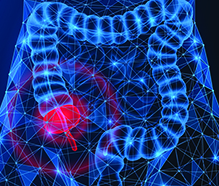by Susan Puckett, PA-C
Internal Medicine at Boulder Medical Center
Appendicitis is inflammation of the appendix, a narrow pouch attached to the large colon. In the United States, one in 15 people will suffer from appendicitis, one of the most common causes of emergency abdominal surgery. Appendicitis usually occurs when this tiny organ becomes blocked by feces, a foreign object, or, rarely, a tumor. Although it can occur at any age, appendicitis is rare for persons under age two and most common for those between ages 10 and 30. Unfortunately, there is no proven way to prevent appendicitis.
Appendicitis is considered a medical emergency. Therefore, prompt diagnosis and surgery for removal are critical. If left untreated, an inflamed appendix will eventually burst or perforate, spilling infectious materials into the abdominal cavity. Although its function is unknown, no long-term consequences are associated with removing the appendix.
Appendicitis Symptoms
Appendicitis is sometimes referred to as the “great masquerader” because symptoms and location of the pain can vary greatly. Diagnosing appendicitis in young children, the elderly, and women of childbearing age can be especially difficult.
The most common symptom of appendicitis starts with a dull pain near or around the belly button. The pain may be mild at first and become sharper as it moves to the lower right abdomen. Loss of appetite and nausea or vomiting occurs soon after the pain begins. There may also be fever, abdominal swelling, bloating, constipation, and difficulty with passing gas.
As swelling in the appendix increases, the pain moves into the lower right abdomen and focuses on a spot above the appendix called McBurney’s point. This pain may occur 12 to 24 hours after the initial symptoms. Others include upper or lower abdomen pain, back, or rectum. Pain levels can vary from dull to sharp.
Summary of Appendicitis Symptoms
- Vomiting that Precedes Abdominal Pain
- Dull Pain Near the Navel or the Upper Abdomen
- Nausea and Vomiting soon after Abdominal Pain Begins
- Loss of Appetite
- Abdominal Swelling
- Fever of 99-102ºF
- Inability to Pass Gas
- Painful Urination
- Severe Cramps
- Constipation or Diarrhea with Gas
- Dull or Sharp Pain Anywhere in the Upper or Lower Abdomen, Back or Rectum
Diagnosing Appendicitis
Doctors can typically diagnose appendicitis by listening to your description of the symptoms and during a physical exam. If you have appendicitis, your pain will increase when the doctor gently presses on your lower right belly area. A rectal exam may find tenderness on the right side of your rectum. Additional tests may include:
Lab Tests
- A Complete Blood Count may Show an Elevated White Blood Count
- Liver Function Testing
- Kidney Function Testing
Diagnostic Studies
- Abdominal CT Scan
- Abdominal Ultrasound
Appendicitis Treatment
Treatment for appendicitis is the surgical removal of the appendix as soon as possible. Suppose a CT scan shows that you have an abscess (a walled-off pocket of infection) from a ruptured appendix. In that case, you may be treated for infection with intravenous antibiotics before surgery. Your appendix is removed after the infection and swelling have gone away.
If your appendix is removed before it ruptures, you will likely recover quickly after surgery. However, your recovery may take longer if your appendix ruptures before surgery; those with compromised immune systems like diabetes may require a longer recovery process.
When to Call your Provider
Call your healthcare provider if you have abdominal pain in the lower-right portion of your belly or any other symptoms of appendicitis.
Also, Call Your Doctor for:
- Severe, Sudden, or Sharp Pain
- Fever with Pain
- Vomiting Blood or Bloody Diarrhea
- Abdomen is Hard and Tender to Touch
- Inability to Pass Stools, Especially if you are Vomiting
- Chest, Neck or Shoulder Pain
- Dizziness or Light-Headedness
- Nausea and a Lack of Appetite with Pain
- Yellowing of Eyes or Skin
- Bloating for more than Two Days
- Diarrhea for More than Five Days (Diarrhea for Two Days or Vomiting for 12 Hours for Infant or Child)
- (Call Right Away if a Baby Younger than Three Months has Diarrhea or Vomiting)
- Abdominal Pain Lasting More than One Week
- Burning with Urination or Frequent Urination
- Worsened Pain when Taking Antacids or Eating
Find a Primary Care Doctor
That’s Right for You
Your primary care provider (PCP) helps you manage day-to-day health needs. Establishing an ongoing relationship with a PCP has been proven to keep you healthier and lower medical costs. At Boulder Medical Center, we’ve got your healthcare needs covered from head-to-toe with top-quality primary care in five Boulder County locations.



